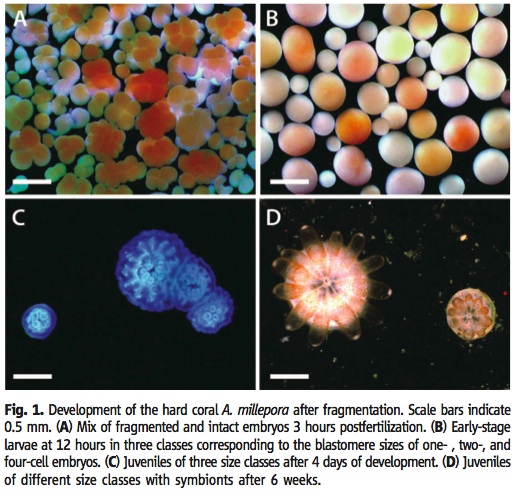I reviewed this paper and have been waiting anxiously for it to appear in print so I could share this remarkable discovery. In short, Dr Andrew Heyward and Dr Andrew Negri of the Australian Institute of Marine Science discovered that coral embryos can survive being broken apart into two small clusters of cells. The two new embryos created from one are genetically identical clones or twins and can go on and settle and grow into normal corals.
After mass spawning events, coral embryos, lacking the protective capsule of other metazoans, are directly exposed to the environment at the ocean surface. Here, we present evidence that modest turbulence disrupts the integrity of these embryos, which fragment into totipotent cells that develop into proportionately smaller functional larvae. The level of turbulence required to fragment coral embryos can be generated from small wind-generated waves, which occur frequently during coral spawning on the Great Barrier Reef. The formation of planktonic coral clones, through natural embryo fragmentation of broadcast spawn, is a previously unknown mode of reproduction in the animal kingdom. – Abstract of Heyward and Negri
The paper appeared today in Science. Read more below from AIMS:
Dr Andrew Heyward and Dr Andrew Negri suspected that fertilised coral eggs (embryos) might also break up because, unlike most animal embryos, coral embryos lack a protective outer-layer or membrane; they are so called ‘naked’ embryos.
“As the early stage embryo develops it divides into a cluster of cells,” explains Dr Heyward, “because this ball of cells lacks a protective outer-layer we wondered whether subjecting them to a little turbulence might cause them break up,”
It did, but what happened next was even more astonishing.
“To our surprise many of the fragmented coral embryos later began to develop and settle in just the same way as their siblings that had remained intact,” continues Dr Heyward. “Interestingly, these fragmented embryos became smaller versions of baby corals than the complete embryos”. The scientists were able to create these turbulent conditions in the laboratory simply by pouring embryos floating in seawater over a vertical distance of 30 cm.
“This effectively mimics the kind of wave height generated by moderate wind speeds where small breaking waves, commonly called whitecaps, occur. That sort of weather is often encountered during a night of coral spawning on the Great Barrier Reef,” says Dr Negri. “So it’s highly likely that this fragmentation occurs regularly on nights when corals release their eggs.
“It appears that the lack of protective membrane is no accident. Almost half of all these naked embryos fragmented in our experiments, suggesting that this has long been part of the corals’ repertoire for maximising the impact of their reproductive efforts”.
Dr Heyward explains why discovery of this novel reproductive strategy is so significant. “This mixed breeding system means colonising corals benefit simultaneously from the advantages of both sexual and asexual reproduction.
“Much like humans, it’s important that the offspring of corals have genetically distinct parents, but these embryos also readily clone to form multiple versions of themselves, and helps to explain how coral maximise their chances of finding a suitable habitat in which to settle and survive.
In human terms this is the equivalent of giving birth to identical twins, triplets, quadruplets and so on.
“This is another example of the complexity of these incredible animals and suggests that there may be more to learn about the lives of corals and their interaction with the environment.”

Leave a Reply